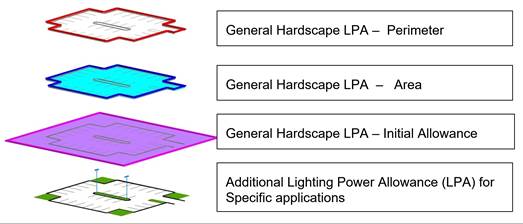
This chapter applies to all outdoor lighting, whether attached to buildings, poles, structures or self-supporting- including but not limited to: lighting for hardscape areas such as parking lots, lighting for building entrances; lighting for all outdoor sales areas; and lighting for building facades.
The outdoor lighting part of the Energy Standards sets minimum control requirements, maximum allowable power levels, minimum efficacy requirements, and cutoff (uplight and glare) zonal lumen limits for outdoor luminaires.
The Energy Standards only permit one type of trade-offs on outdoor lighting power. Refers to Section 6.2.2.1 for details.
All Section (§) and Table references in this Chapter refer to sections and Tables contained in the Energy Standards or California Energy Code.
Outdoor lighting power densities are structured using a layered lighting approach. With the layered approach, the first layer of allowed lighting power is general hardscape for the entire site. After the allowed lighting power has been determined for this first layer, additional layers of lighting power are allowed for specific applications when they occur on the site. For example, the total allowed power for a sales lot with frontage is determined by layering the General Hardscape, Outdoor Sales Lot and Outdoor Sales Lot Frontage allowances, with specific restrictions associated with the location of the power used for frontage and sales lot lighting.
Figure 6-1: Concept of a layered lighting approach for outdoor lighting - Lighting Power Allowance (LPA)

The outdoor lighting applications that are addressed by the Energy Standards are shown in the first two columns of Table 6-1. The first column is general site illumination applications, which allow trade-offs within the outdoor portion only. The second column is specific outdoor lighting applications, which do not allow trade-offs, and are considered “use it or lose it”. The lighting applications in the third column are not regulated. The Energy Standards include control requirements as well as limits on installed lighting power.
The Energy Standards do not allow trade-offs between outdoor lighting power allowances and indoor lighting, sign lighting, heating, ventilation, and air-conditioning (HVAC) system, building envelope, or water heating [(§140.7(a)].
There is only one type of trade-off permitted for outdoor lighting power. Allowed lighting power determined according to §140.7(d)1 for general hardscape lighting may be traded to specific applications in §140.7(d)2, provided the luminaires used to determine the illuminated area are installed as designed. This means that if luminaires used to determine the total illuminated area are removed from the design, resulting in a smaller illuminated area, then the general hardscape lighting power allowance must also be reduced accordingly.
Allowed lighting power for specific applications shall not be traded between specific applications, or to hardscape lighting in §140.7(d)1. This means that for each and every specific application, the allowed lighting power is the smaller of the allowed power determined for that specific application according to §140.7(d)2, or the actual installed lighting power that is used in that specific application. These additional power allowances are “use it or lose it” allowances.
|
Lighting Applications Covered |
Lighting Applications Not Regulated (only as detailed in §140.7) | |
|
|
Specific Applications (trade-offs not permitted) | |
|
The general hardscape area of a site shall include parking lot(s), roadway(s), driveway(s), sidewalk(s), walkway(s), bikeway(s), plaza(s), bridge(s), tunnel(s) and other improved area(s) that are illuminated. |
Canopies: Sales and Non-sales Tunnels Drive-Up Windows Emergency Vehicle Facilities Building Entrances or Exits Building Facades Guard Stations Hardscape Ornamental Lighting Outdoor Dining Primary Entrances for Senior Care Facilities, Police Stations, Healthcare Facilities, Fire Stations, and Emergency Vehicle Facilities Outdoor Sales Frontage and Lots Special Security Lighting for Retail Parking and Pedestrian Hardscape Student Pick-up/Drop-off zone Vehicle Service Station: Canopies, Hardscape, and Uncovered Fuel Dispenser ATM Machine Lighting |
Temporary outdoor lighting Required and regulated by FAA Required and regulated by the Coast Guard. For public streets, roadways, highways, and traffic signage lighting, and occurring in the public right-of-way For sports and athletic fields, and children’s playground For industrial sites For public monuments Signs regulated by §130.3 and §140.8 For stairs and wheelchair elevator lifts For ramps that are not parking garage ramps For themes and special effects in theme parks For outdoor theatrical and other outdoor live performances For qualified historic buildings |
|
Other outdoor lighting applications that are not included in Energy Standards Tables 140.7-A or 140.7-B are assumed to be not regulated by these Standards. This includes decorative gas lighting and emergency lighting powered by an emergency source as defined by the California Electrical Code. The text in the above list of lighting applications that are not regulated has been shortened for brevity. Please see Section 6.2.2.2 for details about unregulated lighting applications. | ||
When a luminaire is installed only to illuminate one or more of the following applications, the lighting power for that luminaire shall be exempt from §140.7(a). Refers to the rightmost column of Table 6-1 for a quick reference to the lighting applications that are exempted. Also the Energy Standards clarify that at least 50 percent of the light from the luminaire must fall within an application in order to qualify as being installed for that application.